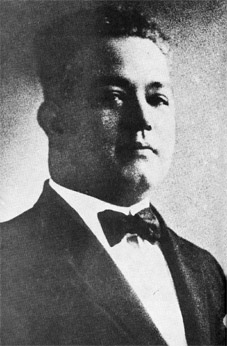Moisés Simons facts for kids
Moisés Simons (born Moisés Simón Rodríguez; August 24, 1889 – June 28, 1945) was a famous Cuban composer, pianist, and orchestra leader. He is best known for composing El Manisero (which means The Peanut Vendor in English). Many people consider El Manisero to be the most famous song ever created by a Cuban musician. It has been recorded by artists all over the world many times.
Contents
Biography
Early Life and Music
Moisés Simons was born in Havana, Cuba, on August 24, 1889. His father, Leandro Simón Guergué, was a musician from the Basque region of Spain. Moisés started learning music from his father at a young age. By the time he was 9, he was already playing the organ at his local church in the Jesús María neighborhood. He was also the choirmaster at the Pilar church, meaning he led the choir.
When he was 15, Moisés studied music even more deeply. He learned about composing music, how different musical notes fit together (harmony), and complex ways of writing music like counterpoint and fugue. He also learned how to arrange music for different instruments (instrumentation).
A Busy Music Career
Later, Simons became a concert pianist, playing music for audiences. He also directed music for theater companies that performed operas and musicals. He worked at the Teatro Martí, where famous Cuban composer Ernesto Lecuona's musical comedies were shown. After that, he moved to the Teatro Payret. There, he worked with Spanish composer Vicente Lleó and toured many Latin American countries, including Mexico, the Dominican Republic, Puerto Rico, and Central America.
In 1924, Simons started his own jazz band. They played on the roof garden of the Plaza Hotel in Havana. His band included instruments like piano, violin, saxophones, flute, banjo, double bass, drums, and timbales. Simons played the piano. In 1928, he hired famous trumpet player Julio Cueva and singer/drummer Enrique Santiesteban. These top musicians earned good money for their time, about $8 a day.
Simons also studied the history of Cuban music. He wrote articles for newspapers and magazines about it. He composed music for stage shows and even for several films. He was also a leader in music organizations, working to support musicians.
Simons became very well-known as a composer during a time called "afrocubanismo." This was between World War I and World War II. During this period, people started to truly recognize the important contributions of Afro-Cubans to Cuban culture. Other famous composers from this time included Alejandro García Caturla and Ernesto Lecuona.
Later Years and Passing
For much of the 1930s, Simons lived and worked in France, mostly in Paris. He was still there when World War II began. He was finally able to return to Cuba in 1942. Later, he moved to the Canary Island of Tenerife in Spain, and then to Madrid, Spain. In Madrid, he signed a contract to create music for a film called Bambú. This film included his last known song, Hoy Como Ayer (meaning Today Like Yesterday).
Moisés Simons passed away in Madrid, Spain, on June 28, 1945. He was 55 years old.
El Manisero (The Peanut Vendor)
The huge popularity of El Manisero brought Moisés Simons worldwide fame. Over a million copies of its sheet music were sold, earning Simons $100,000 in royalties by 1943. This song's success even started a "rumba craze" in the US and Europe that lasted until the 1940s. Its impact was truly far-reaching.
The song was first recorded by singer Rita Montaner around 1927 or 1928. The biggest hit version of El Manisero came from the 1930 recording by Don Azpiazú and his Havana Casino Orchestra. This recording was made in New York City. The band had many star musicians, and Antonio Machín was the singer. It's believed that this recording sold even more than the sheet music, possibly making it the first million-selling record of Cuban or Latin music.
The song's words were based on a street vendor's call, known as a pregón. The music's rhythm was a son, so it was technically a son-pregón. However, on the record label, it was incorrectly called a "rhumba." While the published music credits Simons for both the music and lyrics, there's a story that the lyrics were actually written by Gonzalo G. de Mello. However, experts have doubts about this story because Simons received a lot of money for the song, and Mello never tried to claim he wrote the lyrics. Another idea is that parts of the song came from real-life street vendors' calls from the 1800s. The English version of the song was written by L. Wolfe Gilbert and Marion Sunshine.
In 1947, The Peanut Vendor became a hit again when Stan Kenton and his big band recorded it. It was so popular for Kenton that he recorded it a second time.
Several movies have also featured versions of El Manisero. It appeared in the MGM movie The Cuban Song. Judy Garland sang a part of the song in the 1954 film A Star is Born.
Other Musical Works
Simons also wrote music for operettas and zarzuelas (Spanish musical plays). Some of these include Deuda De Amor, La Negra Quirina, and Toi, c'est Moi. Several of these shows first opened in Paris during the 1930s.
Toi, c'est Moi was an operetta Simons wrote with French novelist Henri Duvernois. It opened in Paris in September 1934 and starred Simone Simon. This show had many different musical numbers mixed with funny comedy scenes. A Cuban music expert, Alejo Carpentier, praised Simons' excellent music and skill in Toi C'est Moi, calling it the best work of Simons' career.
Other well-known songs composed by Simons include Cubanacan, Los Tres Golpes, Así Es Mi Patria, Chivo Que Rompe Tambó, Marta, and Hoy Como Ayer.
Images for kids
See also
 In Spanish: Moisés Simons para niños
In Spanish: Moisés Simons para niños



